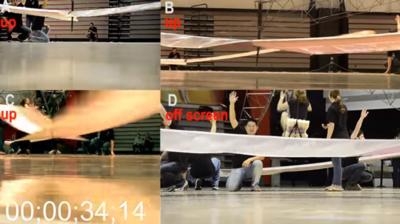Wed, May 11, 2016
The Gamera Project Achieved The Milestone In 2011
On May 12, 2011, biology student and female pilot Judith Wexler flew the human-powered helicopter “Gamera I” for 4.2 seconds in College Park, MD (USA), thus setting the first ever FAI world record in this type of aircraft.

The “Gamera Project” was introduced to try and achieve the dream of human-powered hovering flight. No less than fifty graduate and undergraduate students from the Alfred Gessow Rotorcraft Center of the University of Maryland’s Department of Aerospace Engineering participated in the design and construction of Gamera I. It was made of several lightweight composites and foam, the total weight of this quadrotor helicopter was just about 210 pounds including the pilot. It was built of four trusses, each with a rotor. Both hand and foot pedalling drive the rotors for improved performance. Four cameras were positioned to film the attempt, as the aircraft was so large.
For such records three factors are essential: design, weight, and power. In order to increase the altitude and time in the air, reducing the weight of the aircraft, increasing the efficiency of the rotor design and finding a pilot of just the right size and strength are critical.
Since May 2011, not many records have been set in this very special category. Two months after the first record, Judith managed to supersede her own record with “Gamera II”, a refinement of the “Gamera I”. The current record which was achieved only two years later, is held by Justin Mauch who was airborne for 1 minute and 37.5 seconds. The enormous increase of flight duration between the first and the most recent record shows just how significant and fast the development of human-powered flight has become.
The rules and regulations of Human Powered aircraft are defined in the FAI Sporting Code as an aerodyne that takes off and remains airborne only by direct human muscular energy. It must not use any system of static support such as gas or hot air nor may it carry any kind of apparatus that could receive energy during flight although such equipment may be used to store muscular energy after take-off.
(Source: FAI news release. Image from FAI video)
More News
Aero Linx: Model Aeronautical Association of Australia MAAA clubs are about fun flying, camaraderie and community. For over 75 years, the MAAA has been Australia’s largest fl>[...]
Touchdown Zone Lighting Two rows of transverse light bars located symmetrically about the runway centerline normally at 100 foot intervals. The basic system extends 3,000 feet alon>[...]
“Discovery and innovation are central to our mission at Virgin Galactic. We’re excited to build on our successful record of facilitating scientific experiments in subor>[...]
How To Get A Story On Aero-TV News/Feature Programming How do I submit a story idea or lead to Aero-TV? If you would like to submit a story idea or lead, please contact Jim Campbel>[...]
Student Pilot Reported That During Rotation, “All Of A Sudden The Back Of The Plane Kicked To The Right..." Analysis: The student pilot reported that during rotation, “>[...]
 ANN's Daily Aero-Linx (05.02.24)
ANN's Daily Aero-Linx (05.02.24) ANN's Daily Aero-Term (05.02.24): Touchdown Zone Lighting
ANN's Daily Aero-Term (05.02.24): Touchdown Zone Lighting Aero-News: Quote of the Day (05.02.24)
Aero-News: Quote of the Day (05.02.24) ANN FAQ: Contributing To Aero-TV
ANN FAQ: Contributing To Aero-TV NTSB Final Report: Cirrus Design Corp SR20
NTSB Final Report: Cirrus Design Corp SR20



